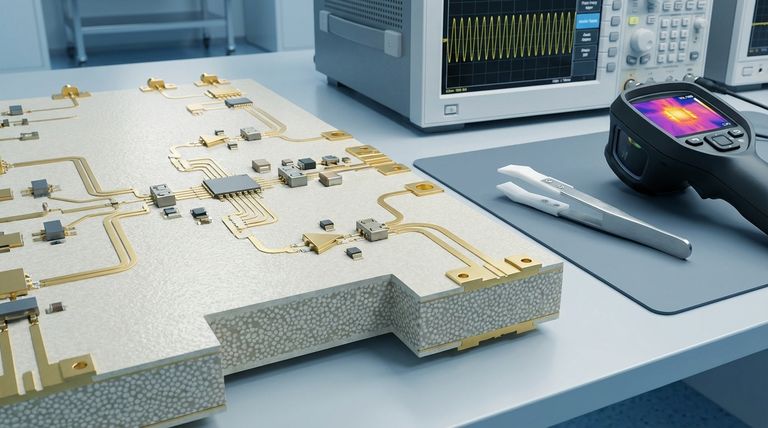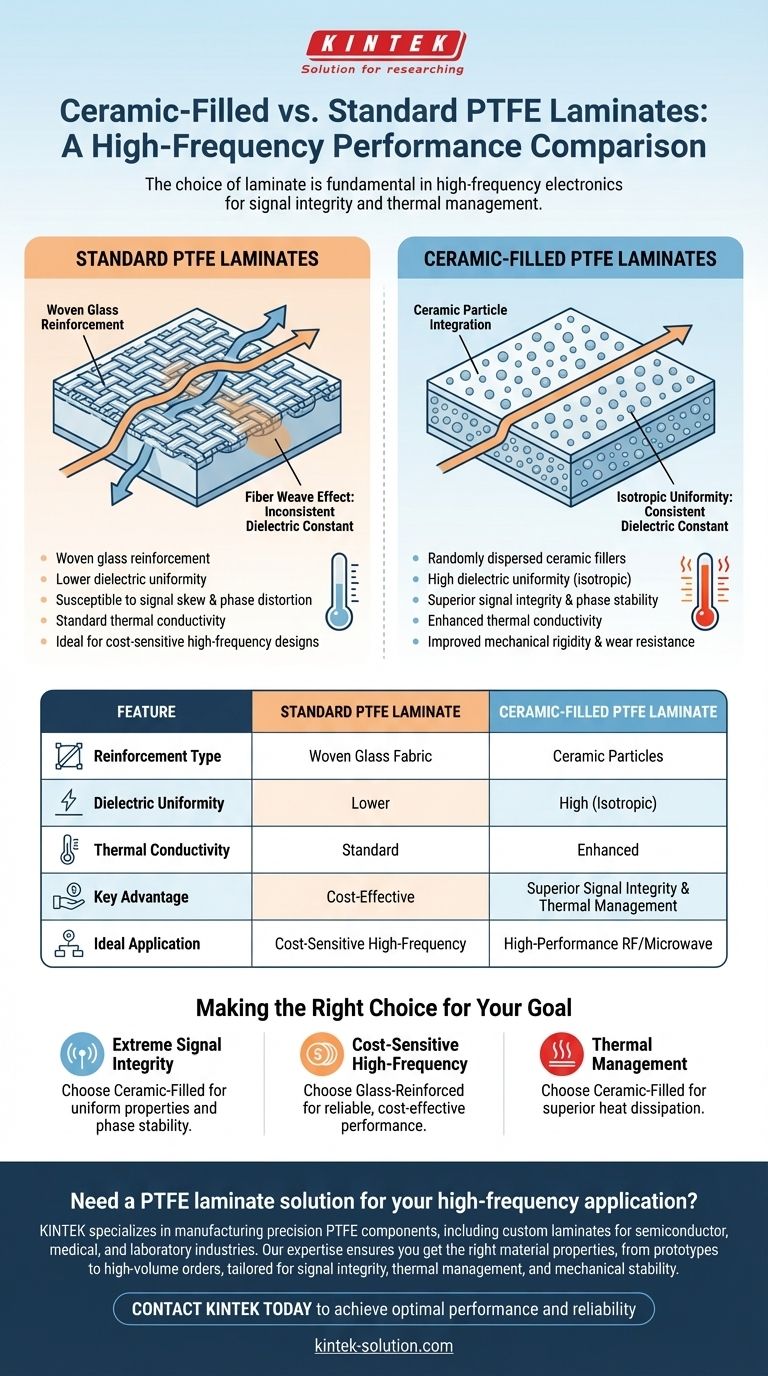In high-frequency electronics, the choice of laminate is fundamental. Ceramic-filled Polytetrafluoroethylene (PTFE) laminates are a specialized evolution of standard PTFE-based materials. They integrate microscopic ceramic particles into the PTFE matrix to significantly improve thermal conductivity and mechanical rigidity. Most critically, this addition provides uniform electrical properties, which standard glass-reinforced PTFE can struggle to achieve at very high frequencies.
While both materials leverage PTFE's excellent electrical properties, the choice of filler is the critical differentiator. Ceramic-filled laminates typically replace woven glass reinforcement to eliminate the 'fiber weave effect,' resulting in superior signal integrity and thermal management for demanding RF and microwave applications.

The Core Problem with Standard Reinforcements
To understand the value of ceramic fillers, we must first understand why PTFE needs reinforcement at all and the limitations of the most common method.
PTFE's Need for Reinforcement
Pure PTFE is an exceptional insulator with a very low dielectric constant (Dk) and loss tangent, making it ideal for high-frequency signals.
However, pure PTFE is mechanically soft and has a high coefficient of thermal expansion. For use in a rigid Printed Circuit Board (PCB), it requires a reinforcing material, which is most commonly woven glass fabric.
The "Fiber Weave Effect" Explained
Woven glass provides the necessary rigidity, but its fibrous structure creates microscopic inconsistencies in the laminate.
The signal path on a PCB will cross over areas with more glass fiber (higher Dk) and areas with more PTFE resin (lower Dk). This inconsistent dielectric constant can cause signal skew and phase distortions, which become significant problems in high-speed digital and RF/microwave systems.
How Ceramic Fillers Provide a Superior Solution
Ceramic-filled laminates solve the problems created by woven glass by using a different approach to reinforcement. The ceramic particles are distributed evenly throughout the PTFE.
Isotropic and Uniform Electrical Performance
Instead of a structured weave, the randomly dispersed ceramic particles create a material that is isotropic, meaning its electrical properties are the same in every direction.
This uniformity eliminates the fiber weave effect. It ensures a consistent dielectric constant across the entire board, leading to predictable signal behavior, minimal skew, and stable phase response—all critical for high-fidelity systems.
Enhanced Thermal Conductivity
Ceramics are generally better thermal conductors than glass fibers or PTFE resin.
Integrating ceramic particles into the laminate creates a more efficient pathway for heat to dissipate away from active components like power amplifiers. This improved thermal management increases component reliability and performance.
Improved Mechanical Stability and Strength
The ceramic fillers add significant rigidity and dimensional stability to the PTFE. This results in a mechanically robust laminate with improved wear resistance compared to many standard glass-reinforced options.
Understanding the Trade-offs
While ceramic-filled laminates offer clear advantages, there are practical considerations to keep in mind.
Cost Considerations
Ceramic-filled materials are often more expensive than their glass-reinforced counterparts. However, for applications where their specific benefits are required, they become cost-effective by enabling higher performance and reliability that would otherwise be unattainable.
"Reinforced" vs. "Filled" Terminology
It is important to note that material vendors sometimes use the terms 'ceramic-reinforced' and 'ceramic-filled' interchangeably. Always consult the material datasheet to understand the specific composition and properties.
Fabrication Challenges
While based on PTFE, these advanced laminates can have unique processing requirements compared to more common materials like FR-4. Working with an experienced PCB fabricator who understands these materials is crucial for success.
Making the Right Choice for Your Goal
The decision between standard glass-reinforced and ceramic-filled PTFE laminates hinges on the specific demands of your application.
- If your primary focus is extreme signal integrity for high-frequency RF/microwave circuits: Ceramic-filled PTFE is the superior choice for its uniform electrical properties and phase stability.
- If your primary focus is cost-sensitive high-frequency design where minor signal variations are acceptable: Glass-reinforced PTFE offers excellent performance and is a proven, reliable option.
- If your primary focus is thermal management for high-power components: The enhanced thermal conductivity of ceramic-filled laminates makes them a clear winner.
Ultimately, selecting the right PTFE laminate depends on a clear understanding of your circuit's sensitivity to signal phase, thermal load, and mechanical stress.
Summary Table:
| Feature | Standard PTFE Laminate | Ceramic-Filled PTFE Laminate |
|---|---|---|
| Reinforcement Type | Woven Glass Fabric | Ceramic Particles |
| Dielectric Uniformity | Lower (Fiber Weave Effect) | High (Isotropic Properties) |
| Thermal Conductivity | Standard | Enhanced |
| Key Advantage | Cost-Effective | Superior Signal Integrity & Thermal Management |
| Ideal Application | Cost-Sensitive High-Frequency | High-Performance RF/Microwave |
Need a PTFE laminate solution for your high-frequency application?
At KINTEK, we specialize in manufacturing precision PTFE components, including custom laminates for the semiconductor, medical, and laboratory industries. Our expertise ensures you get the right material properties—whether you need the uniform electrical performance of ceramic-filled PTFE or the cost-effectiveness of standard reinforced PTFE.
We offer custom fabrication from prototypes to high-volume orders, tailored to your exact requirements for signal integrity, thermal management, and mechanical stability.
Contact us today to discuss your project and let our experts help you achieve optimal performance and reliability.
Visual Guide

Related Products
- Custom PTFE Parts Manufacturer for Teflon Parts and PTFE Tweezers
- Custom PTFE Parts Manufacturer for Teflon Containers and Components
- Custom PTFE Sleeves and Hollow Rods for Advanced Applications
- Custom PTFE Teflon Parts Manufacturer Adjustable Height Flower Basket
- Custom PTFE Teflon Parts Manufacturer PTFE Magnetic Stirring Bar
People Also Ask
- What chemical processing applications involve PTFE-machined parts? Essential Components for Corrosive & High-Purity Systems
- What challenges arise when machining PTFE (Teflon)? Overcome Softness, Heat, and Instability
- What are the unique properties of PTFE? Unlock Unmatched Performance in Demanding Applications
- What are the unique properties of PTFE? The 3 Pillars Driving Demand for High-Performance Parts
- What industrial benefits do PTFE-machined parts offer? Achieve Peak Performance in Demanding Applications



















